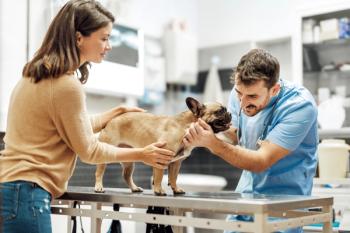
The ABCs of veterinary dentistry: N is for no
By nature of the alphabet, we must get through all of the noes in veterinary dentistry before we can reach the yesesbut that doesnt mean you wont feel positively inspired to better your dental practices after reading.
As veterinarians, we respond to clinical signs in our patients and do something about them. But knowing what not to do is just as important. Here are 14 things to say no to in veterinary dentistry:
1. Say no to treatment estimates related to oral malodor (halitosis) before you've examined the entire mouth-including every tooth.
Quoting a fee (or even a fee range) for “bad breath” before you know the cause may lead to a disgruntled client and an untreated patient once you discover that a dozen teeth suffer from advanced periodontal disease and need to be extracted. Instead, let your client know you'll call while the pet is anesthetized to discuss what care the pet needs after dental scaling, probing and full-mouth intraoral radiographs.
2. Say no to dental procedures without general anesthesia.
Anesthesia allows the practitioner and assistants to carry out dental procedures safely and effectively, minimizing the risk of injury to the team, equipment and patient. The American Veterinary Dental College (AVDC) launched a
A similar
3. Say no to dental procedures without an examination.
In some veterinary clinics, the pet owner calls the office to arrange a drop-off for a teeth cleaning because the pet has oral malodor. But if your dental assistant only removes the pet's plaque and tartar from the crowns without a tooth-by-tooth examination, you've accomplished little besides the cosmetic removal of crown debris. Oral malodor occurs secondary to food putrefying in periodontal pockets. Unless you treat the pockets (through deep scaling and root planing, gingivectomy or placement of local antimicrobials into cleaned pockets) and institute home care, malodor will soon return and periodontal disease will progress.
A healthier way to approach dentistry with long-term positive results is to examine the conscious patient first (including the oral cavity), followed by a tooth-by-tooth examination under general anesthesia (with probing and intraoral radiology). If the tooth and support structures are in good shape, move on to the next tooth. If not, diagnose the pathology and formulate a treatment and prevention plan (Figures 1A-1D).
Figure 1A. 12-mm probing depth along the mesial aspects of the left maxillary fourth premolar; extraction indicated. (All images courtesy of Dr. Jan Bellows.)
Figure 1B. Periodontal probe before insertion into a dog's partially erupted left mandibular canine.
Figure 1C. 10-mm periodontal pocket; gingivectomy, mucogingival surgery or extraction indicated.
Figure 1D. Bleeding on probing with 3-mm periodontal pockets; root planing and instillation of local antibiotics indicated.
4. Say no to the following phrase: “The patient is here for a dental today … ”
When properly performed, what we do is a comprehensive oral prevention, assessment and treatment visit. If you regularly vocalize all of these terms, the client develops a better understanding of and appreciation for what's involved. Note that
5. Say no to too many dental cases per veterinarian per day.
Once the entire team embraces the comprehensive oral prevention, assessment and treatment concept, everyone wins-especially the patient. And with 42 “patients” in every normal dog's mouth and 30 in every normal cat's, you'll need to give yourself a lot of time to properly treat the cause of oral malodor.
6. Say no to dentistry without patient warming systems.
Small animal dental procedures are commonly conducted in an air-conditioned environment, which decreases the patient's core body temperature over time. Dental diagnostic and treatment procedures can be lengthy, and managing the patient's core body temperature is recognized as one of the best ways to minimize the risk of an anesthetic complication. Careful monitoring and treatment of falling body temperature can help you avoid significant physiological and surgical complications as well.
The patient's temperature is monitored through esophageal or rectal probes, with the former being a more accurate representation of core body temperature. Provide a safe method of thermal support such as forced air and radiant heating systems (Figure 2). You must take care to avoid thermal injury to the skin with other types of heating devices.
Figure 2. Radiant energy warming device (
Scaling plaque and calculus from crowns and probing pockets only goes so far. At least 60% of the patient's teeth lie below the gum line. Intraoral radiographs are essential to help you evaluate these areas (Figures 3A-3D).
Figure 3A. Seemingly normal incisors in a canine patient.
Figure 3B. Enlarged root canal and periapical lucency consistent with a nonvital tooth in the canine patient from Figure 3A; root canal therapy or extraction is indicated.
Figure 3C. Advanced periodontal disease in the canine patient from Figure 3A affecting the apices of the right maxillary fourth premolar and the first and second molars; extractions indicated.
Figure 3D. Advanced periodontal disease in the canine patient from 3A affecting the left mandibular fourth premolar and second and third molars; extractions indicated. Stage 3 periodontal disease affecting the left mandibular first molar; root planing coupled with home care or extraction indicated.
8. Say no to technician extractions.
Some state
9. Say no to unsterilized and dull instruments.
Can you imagine your dentist opening up a drawer and rummaging through the instruments inside before dipping them in cold sterile solution to extract your tooth? Sterilized packs for diagnostics (periodontal probe, mirror and curette), extractions (separate packs for feline and small, medium and large dogs) and oral surgery make great sense. To increase efficiency, keep all of the instruments you need for a specific procedure together in one sterile pouch or cassette. Charging a “sterile surgical pack fee” easily covers the expense of additional instruments and sterilization.
Your instruments need to be sharp, too. Before sterilization, sharpen your curettes and your wing-tipped and periosteal elevators with an oiled sharpening stone (Figures 4A-4E).
Figure 4A. Unsterile surgical instruments; note the dog hairs.
Figure 4B. Instruments in the author's extraction pack.
Figure 4C. Cassette with oral surgical instruments.
Figure 4D. Sharpening stone and oil.
Figure 4E. Sterile piezo ultrasonic tip. 10. Say no to spring-loaded mouth gags.
You can insert a mouth prop or lap sponge between the maxillary and mandibular canines or between the cheek teeth to keep the mouth open during dental procedures. Placing spring-loaded gags between canines is not recommended because of potential iatrogenic damage to the teeth, temporomandibular articulation and decreased maxillary blood flow to the brain. In cats, this decreased cerebral blood flow may result in neurological impairment, including blindness. Alternatively, cut endotracheal tubes or syringes will prop the mouth open while allowing for flexibility (Figure 5).
Figure 5A. Don't use spring-loaded mouth gags like this one. They can cause overextension of the temporomandibular joint.
Figure 5B. Don't overextend the temporomandibular joint as in this image with a cut syringe.
11. Say no to extractions without regional anesthesia and postoperative pain medication.
No animals under our care should experience pain when it can be prevented. The benefits of regional anesthesia include decreased pain during and after surgical procedures, decreased risk of vagally mediated reflex bradycardia, lower inhalant requirements, and a level plane of general anesthesia reducing the variation of anesthetic depth when painful stimulation occurs.
The three most common regional blocks in veterinary dentistry are the caudal maxillary, infraorbital and caudal mandibular blocks. Frequently administered single-agent local anesthetics include lidocaine and bupivacaine. Many practices use a combination of 0.5% bupivacaine hydrochloride with epinephrine (Marcaine) (1 mg/kg) and lidocaine 2% (1 mg/kg) in a 4:1 ratio. Mixing 0.8 ml of bupivacaine with 0.2 ml of lidocaine in the same tuberculin syringe accomplishes the 4:1 ratio. The recommended volume for regional anesthesia is 0.1-0.3 ml per injection site. Maximum patient dosage of this mixture is 0.2 ml/kg bupivacaine, or approximately 0.25 ml per jaw quadrant (in case all quadrants need anesthesia for a 5-kg cat or dog).
Another option is to mix small volumes of an opioid with a local anesthetic. Buprenorphine has been shown to extend anesthetic duration up to threefold compared with bupivacaine alone. Small volumes of buprenorphine 0.003 mg/kg can be mixed with bupivacaine hydrochloride in the patient's regional block volume.
All dogs and cats should receive postoperative pain relief medication after extractions for at least three days.
12. Say no to systemic antibiotics-except in cases of advanced periodontal disease or in compromised patients.
Forty years ago, the standard of care included giving a penicillin-streptomycin injection after every ovariohysterectomy. Once the science proved this wasn't necessary, it stopped. Similarly, systemic antibiotics are not indicated before, during or after most dental procedures, other than cases of multiple extractions for advanced periodontal disease where we are removing the cause of the problem (e.g. plaque, tartar and periodontally affected teeth).
There appears to be a place for local administration of antimicrobials, however, especially in cleaned periodontal pockets less than 5 mm (Figure 6).
Figure 6. Injection of local antibiotic into a cleaned stage 2 periodontal pocket.13. Say no to recommending tooth brushing.
Wait. Did you read that right? No to the gold standard of tooth brushing? What's wrong with tooth brushing? Simple: Virtually no one does it twice a day, or once a day, or even every other day, and anything less is worthless. So instead of continuing to push brushing, recommend twice-daily wipes, cotton-tipped applicators (in cats) rubbed along the gingival margin, and
14. Say no to forgetting to schedule follow-up dental examinations.
Removing the plaque and tartar from crown and root surfaces and extracting teeth affected by advanced periodontal disease without periodic home care monitoring makes little sense. Plaque and tartar will soon return and inflame the gingiva. After the comprehensive oral prevention, assessment and treatment visit, schedule a follow-up appointment to discuss a tailored plaque control program, including monthly to quarterly rechecks, to monitor compliance and efficacy.
Now that the negativity of saying no is out of the way, I look forward to getting to “Y” (“Say yes to … ”) in a future piece.
Newsletter
From exam room tips to practice management insights, get trusted veterinary news delivered straight to your inbox—subscribe to dvm360.






